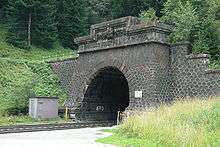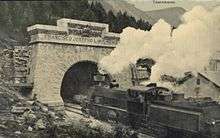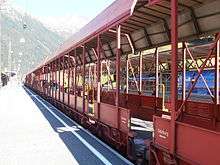Tauern Railway Tunnel
The Tauern Railway Tunnel (German: Tauerntunnel) in Austria is the longest tunnel of the Tauern Railway crossing the main chain of the Alps. Currently, it has a length of 8.371 kilometres (5.201 mi). The highest point of the tunnel, which is also the highest point in all of the railway line, is at 1,226 metres (4,022 ft) above sea level. The tunnel's north entrance is at Böckstein in the valley of Bad Gastein in the state of Salzburg, the south entrance near Mallnitz in Carinthia.
 South portal near Mallnitz | |
| Overview | |
|---|---|
| Line | Tauern Railway |
| Location | Hohe Tauern, Central Eastern Alps |
| Start | Böckstein, Bad Gastein, Salzburg |
| End | Mallnitz, Carinthia |
| Operation | |
| Work begun | 1901 |
| Opened | 1909 |
| Operator | Austrian Federal Railways |
| Traffic | Train |
| Technical | |
| Line length | 8,371 m (27,464 ft) (1909: 8,550 m (28,050 ft)) |
| No. of tracks | Double track |
| Track gauge | 1,435 mm (4 ft 8 1⁄2 in) (standard gauge) |
| Highest elevation | 1,226 m (4,022 ft) |
Construction

Plans for constructing an interconnection railway line between the terminus of the Austrian Western Railway at the city of Salzburg and Villach leading to the Southern Railway already existed in the 1880s. This line would be especially important for the transportation of goods between the industrialised north of Austria-Hungary and Trieste, then the monarchy's main port on the Adriatic Sea. It was only after the Austrians had watched their neighbours, the Swiss, obtain a remarkable achievement, as they managed to finish their Gotthard Tunnel, as early as 1881.
Planning for the Tauern railway line and tunnel started in the early 1890s. Tunnelling began in July 1901 from the north side, work on the south side started in October of that same year. The work was supervised by Civil Engineer Karl Wurmb (1850-1907), whilst most of the backbreaking labour was performed by an Italian workforce. Despite many difficulties, construction was finished in 1906. The official opening took place on 5 July 1909 in presence of Emperor Francis Joseph, along with the rest of the Tauern Railway line. Although many other parts of the line were single track, the tunnel was equipped with two tracks from the beginning.
Between 1925 and 1935, the tunnel was electrified, along with the rest of the line. With steam locomotives having been replaced by electric ones, the air intakes, formerly needed to supply the tunnel with extra fresh air, were no longer necessary. Between 2000 and 2004, the tunnel underwent extensive renovation works. During the works, the northern tunnel entrance was altered. There used to be a rather notorious curve near this entrance, in which many trains used to derail. The first part of the tunnel, which was not very deep underground, was dug open, moving the tunnel entrance 179 metres back, shortening the tunnel's length from 8,550 to 8,371 metres.[1] The old tunnel entrance remained in its original place, now serving as a memorial arch. Also during the renovation, all the rails and power lines were replaced, damaged sections of the tunnel wall were repaired, and fire detection systems were installed.
Autoschleuse

Ever since the First World War, motor vehicles are being transported by train from one side to the other. The Autoschleuse or Tauernschleuse, known in English as Tauern Motorail consists of a specially adapted car shuttle train, with the possibility to load and unload many cars in a short amount of time. Since the safety rules were sharpened, the train also consists of several passenger carriages and passengers travel within them.[2]
Safety issues
After a large number of serious accidents, in Austria (Tauern Road Tunnel, 29 May 1999) as well as in other countries, (Mont Blanc Tunnel, 24 March 1999, Gotthard Tunnel, 24 October 2001), the Austrian government expressed its concerns about the safety in tunnels, not only in road tunnels, but also in railway tunnels, considering the large amounts of dangerous goods being transported through them. With the scheduled renovation came the installation of extensive systems for fire detection, emergency report systems and escape route indications. The car transport system was also adapted to new safety regulations. Formerly, passengers using the Autoschleuse were allowed to stay in their cars during the 11-minute journey. Nowadays, all passengers have to get into a passenger carriage directly behind the locomotive. Special fire extinguishing trains are located at both ends of the tunnel.
History
1947 Train Bombing
On August 12, 1947, a bomb exploded under a British military train carrying 175 people from London to Villach. The bomb exploded under the baggage compartment and injured one soldier. A second bomb failed to explode, they were intended to derail the train over a steep cliff. The terrorist group Irgun was later implicated in the attack.[3][4][5]
References
- ÖBB Infrastruktur Betrieb: Eisenbahnatlas Österreich. Verlag Schweers + Wall, Cologne 2005, ISBN 3-89494-128-6.
- Institut für Österreichkunde (Hrsg.): Österreich in Geschichte und Literatur. ÖGL. Mit Geographie. Band 41. Braumüller, Vienna 1997, Permalink Österreichischer Bibliothekenverbund, p. 180.
- 175 Britons Escape in Rail Blast Near Tunnel in the Austrian Alps NY Times, August 14, 1947
- Irgun Boasts of Alps Blast NY Times, August 19, 1947
- Irgun's Hand Seen in Alps Rail Blast NY Times, August 16, 1947
External links
![]()